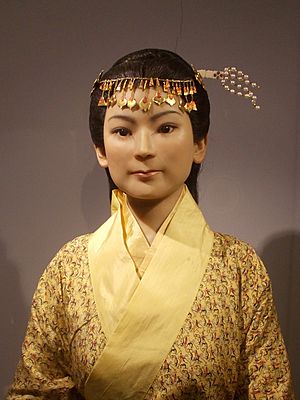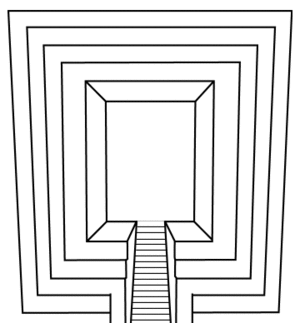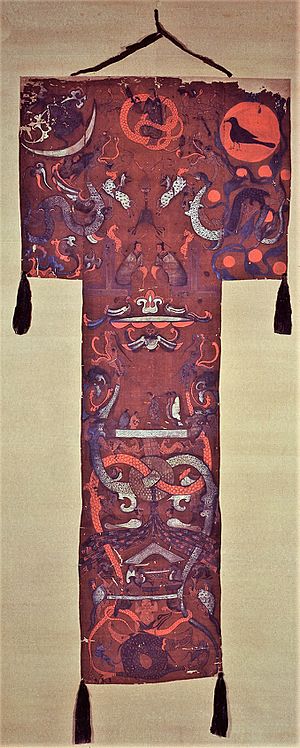Xin Zhui facts for kids
Quick facts for kids
Xin Zhui
|
|
|---|---|
| Marquise of Dai | |

A wax sculpture reconstruction of Xin Zhui
|
|
| Dynasty | Han dynasty |
| Born | c. 217 BC |
| Died | 168 or 169 BC (aged 48–49) |
| Buried | Mawangdui, Changsha, Hunan Province, China |
| Husband | Li Cang (利蒼), Marquis of Dai and Chancellor of Changsha Kingdom |
| Xin Zhui | |||||||||||||||||||||
|---|---|---|---|---|---|---|---|---|---|---|---|---|---|---|---|---|---|---|---|---|---|
| Chinese | 辛追 | ||||||||||||||||||||
|
|||||||||||||||||||||
Xin Zhui (born around 217 BC, died 168 or 169 BC), also known as Lady Dai, was a noblewoman from ancient China. She lived during the Western Han dynasty. Her husband was Li Cang, the Marquis of Dai and an important official.
Xin Zhui's tomb was found in 1971 in Mawangdui, China. Inside, her body was amazingly well-preserved. Over 1,400 artifacts were also discovered with her. Her body and belongings are now cared for by the Hunan Museum. Her mummy is famous for being one of the best-preserved ever found.
Contents
Life of Lady Dai
Xin Zhui lived a very rich and comfortable life. She had her own musicians who played for her parties. They also played just for her enjoyment. She might have enjoyed playing music herself, especially the guqin. This instrument was linked to being refined and smart.
As a noble, Xin Zhui ate many special foods. These included different kinds of meat. Such foods were usually only for the royal family. Most of her clothes were made of silk and other valuable fabrics. She also owned many cosmetics.
As she grew older, Xin Zhui faced many health problems. These issues eventually led to a heart attack that caused her death. She suffered from conditions like heart disease and high blood pressure. She also had problems with her liver and gallstones. These health issues likely made her less active.
Researchers found 138 melon seeds in her stomach and intestines. This suggests she ate the melon very quickly. It is believed she died in the summer, when melons ripen. The melon seeds also show she died within a few hours of eating the fruit. Xin Zhui died when she was about 50 years old.
Discovery of the Tomb
In 1968, workers were digging an air raid shelter near Changsha. They accidentally found Xin Zhui's tomb. They also found the tombs of her husband and a young man, likely her son. With help from over 1,500 local high school students, archaeologists began digging in 1972.
Xin Zhui's body was found inside four wooden coffins. These coffins were placed one inside the other. They were buried under layers of charcoal and white clay. Her body was wrapped in twenty layers of clothing. These clothes were tied with silk ribbons.
The outermost coffin was painted black. This color represented death and the underworld. The paintings inside were for Xin Zhui, not for people outside. They showed themes of death, rebirth, and protection in the afterlife. The second coffin had a black background with clouds and protective animals. A small figure of Xin Zhui was shown entering this mysterious world.
The third coffin was bright red, a color for immortality. It had images of divine animals and a winged immortal. These were near Mount Kunlun, a symbol of eternal happiness. On top of the innermost coffin, a painted silk banner was found. It was about two meters long. Yellow and black feathers were stuck to the coffin cover. People hoped these feathers would help Xin Zhui grow wings and become immortal in heaven.
Xin Zhui's body was incredibly well-preserved. It was found in an unknown fluid inside the coffin. Her skin was soft and moist. Her arms and legs could still bend. All her organs and blood vessels were intact. Small amounts of Type A blood were found in her veins. She still had hair on her head, with a wig pinned at the back. Her eyelashes and nose hair were still there. Her left eardrum was whole, and her fingerprints were clear.
This amazing preservation allowed doctors to perform an autopsy in 1972. Much of what we know about Xin Zhui's life comes from these examinations. As a noble, her body was likely washed with fragrant water and wine. The unknown fluid in her coffin was acidic. This may have stopped bacteria from growing. Many scientists think the fluid was from her body, not poured in.
More than 1,400 valuable items were found with Xin Zhui. These included 100 silk garments and 182 pieces of expensive lacquerware. There were also makeup items and 162 carved wooden figures of servants. In the Western Han Dynasty, grand burials were common. People believed the dead needed food and shelter in the afterlife. They thought necessities from life should be buried with them. The importance of filial piety (respect for elders) also led to such lavish burials.
How the Body Was Preserved
Scientists believe three main things helped preserve her body. First, her body was carefully prepared for burial. This slowed down the first stages of decay. Second, her body was placed in airtight coffins. Lastly, the burial chamber was deep underground. It was surrounded by charcoal and white clay. This kept water and air out, and the temperature stayed cool. However, scientists are still not sure exactly why her body was so well preserved.
Why Xin Zhui's Discovery Is Important
Xin Zhui's tomb holds some of the best-preserved human remains ever found in China. The items in her tomb also taught us a lot about life in the Han dynasty. This information was not known before. Her discovery continues to help archaeology and science today. Especially in how we preserve ancient human remains. In 2003, scientists even developed a special compound. It was injected into Xin Zhui's blood vessels to help keep her preserved.
Her funerary banner had ancient Han dynasty art on it. The woman at the top might be Xin Zhui herself. She is shown possibly becoming a xian, which is an immortal being.
See also
 In Spanish: Xin Zhui para niños
In Spanish: Xin Zhui para niños
- Mawangdui Silk Texts



